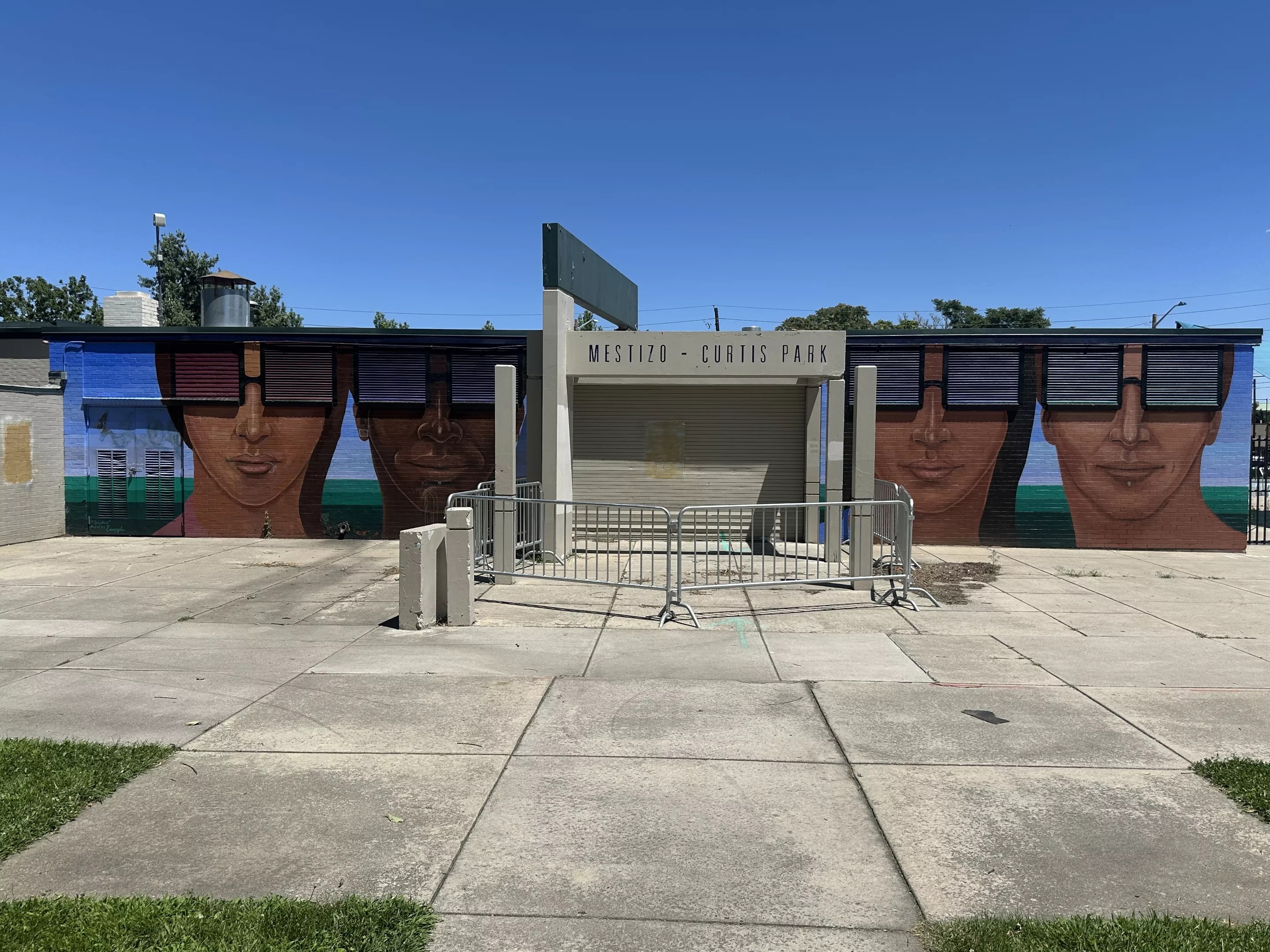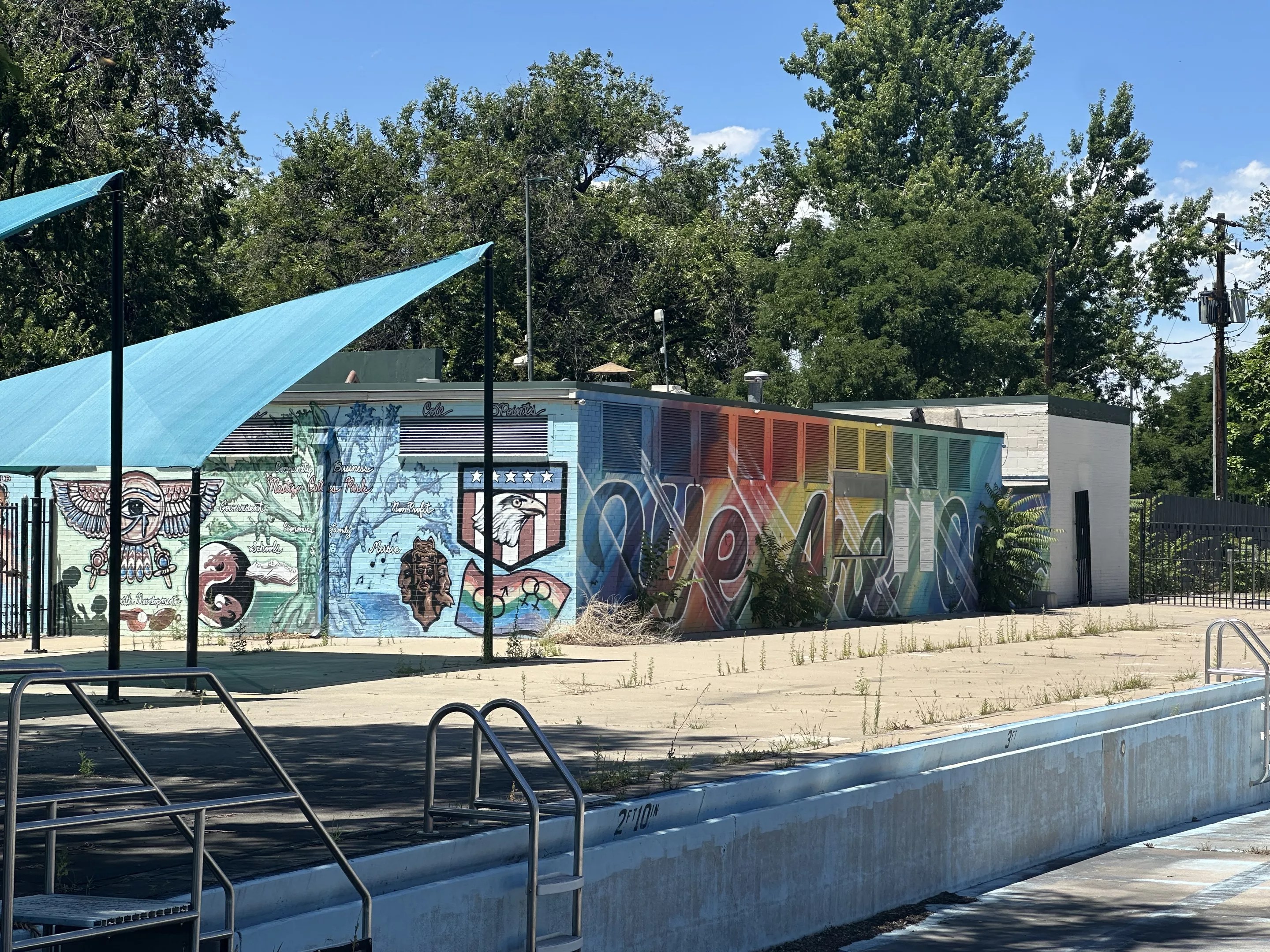
Teague Bohlen

Audio By Carbonatix
It’s not just about the murals this time: Progress on the Mestizo-Curtis Park Pool project stalled on August 5, after a passionate outcry from current and former residents of the historic Curtis Park neighborhood during a Landmark Preservation Commission hearing.
The hours-long meeting of the LPC, which falls under Denver Community Planning & Development, began with questions and comments from residents – well over thirty minutes of them. Some objected to specific design elements: a curb-cut that might prove dangerous to pedestrians and kids, the moving of the pool entrance from inside the park to street-side, and other safety elements.
There were also more complaints about why Emanuel Martinez’s “Eyes on the Park” mural couldn’t be preserved. As resident Eileen Feltman put it: “If blocks can be cut out and preserved for Banksy and the Berlin Wall, the same can happen here.”
Milo Martinez put it more succinctly, calling the project “just another form of gentrification.”
This year, make your gift count –
Invest in local news that matters.
Our work is funded by readers like you who make voluntary gifts because they value our work and want to see it continue. Make a contribution today to help us reach our $50,000 goal!
There were actually two issues on the LPC’s August 5 agenda regarding the Mestizo-Curtis Park Pool project. The first was the Application for Demolition. The design team, led by architect James Braam on behalf of the engineering and architecture firm HDR, addressed the matter of the mural by saying that preservation wasn’t feasible, but didn’t elaborate. As the mural’s decommissioning had already been approved, the LPC voted unanimously to approve the demolition with one condition: there be an approved replacement structure before the tear-down began.

The old facility has a number of other murals.
Teague Bohlen
The second issue involved what would replace the demolished facility; the LPC is involved because Curtis Park is a designated historic neighborhood, and new structures must work in terms of mass, form and scale.
The questions this time came from the LPC itself. Members of the commission brought up the lack of windows, and how certain design opportunities involving the roof were missed. They also wondered how design decisions were made.
Representatives of HDR and Denver Parks & Recreation, which oversees the property, responded to many of these concerns by referring to neighborhood surveys that they said suggested most residents wanted a “modern” design with a smaller lap pool to make room for a larger leisure pool.
According to two online surveys conducted in late 2024, 57 percent of respondents preferred a “modern” style, with 23 percent opting for “classic” and 20 percent choosing “contemporary.” The reduction of the lap pool from the current 50 meters down to 25 was also supported by the survey, with 38.6 percent preferring a 25-meter lap pool and a larger leisure pool, as opposed to 26.9 percent wanting to maintain the 50-meter lap pool and have a smaller leisure pool. And 34.5 percent of those responding said they were fine with just a giant leisure pool and no lap pool at all.
But residents and LPC members alike had objections to the reported results.
Neighborhood activist Sue Glassmacher repeated her claim from earlier meetings that the survey wasn’t reflective of the black and brown population of Curtis Park and Five Points, noting that more than half of respondents were white women of an age most likely to have children, not the low-income families of color who most often use the pool facilities.
“It almost feels like a biased survey,” said commission member Nick Foussianes, who worried that architectural-era definitions were too undefined for the untrained public.
After he called the visual appeal of the proposed design “prison-like,” and fellow commission member Rusty Brown added, “I think it fails in terms of reflecting the context it’s in. It’s a really alien building to me.”
Perhaps one of the most telling moments came in a comment from an LPC member about the current design being “a lot of beige.” Murals might be a solution, some people pointed out, because those that are deemed culturally appropriate tend not to be defaced, and including murals might not only serve as outreach to the community but also save the city money in the long run. Emily Ziegler, assistant director of DPR’s Parks & Facilities Projects, noted that the glazed block used in the design, while expensive, has a surface that can repel graffiti to a point; she did not address the cultural benefits of murals.
“This is the way the process has been going from the start,” protested Keith Pryor, a Curtis Park resident, contractor and small business owner. “They don’t want to hear about solutions, or even about the problems we’re pointing out. It’s all about expediency.”
Commission Chair Erika Warzel was a little more diplomatic in summing up the situation. “This is a challenge,” she said, choosing her words with apparent precision. “It’s a civic building that’s being replaced with another civic building, and it’s hard to have immediate translation between that and the historic buildings that we have in this historic district. As far as having a building that includes the features and rhythms of those historic buildings, I don’t see that this [plan] meets that in any way.”
She went on to suggest that “some good-faith efforts of different designs, and the commission’s vote to deny the initial design was unanimous.
According to Denver Parks & Recreation Marketing and Communications Specialist Stephanie Figueroa, “DPR has already begun engaging with the Council Office and with community members who attended the Landmark meeting to gather their feedback for the next iteration of design for this project. We look forward to working with the community to deliver an amazing amenity for everyone.”
The community is ready to keep providing feedback. “We’ve been in contact with members of La Raza and other Chicano neighbors,” Pryor notes, “[and] are now working together to ensure the broader community has an understanding of what is being proposed for the new pool facility. There were never community conversations until now. We believe Curtis Park and Five Points will be stronger communities because of this process.
Listen to some of the meeting below.